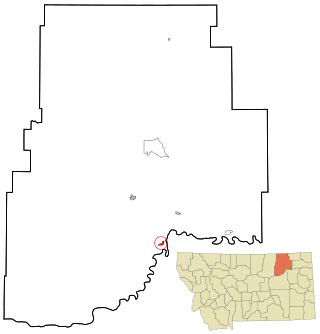
Fort Peck is a town in Valley County, Montana, United States. The population was 239 at the 2020 census.

The West Point Light, also known as the Discovery Park Lighthouse, is an active aid to navigation on Seattle, Washington's West Point, which juts into Puget Sound and marks the northern extent of Elliott Bay. The lighthouse is similar in design to the Point No Point Light and was added to the National Register of Historic Places in 1977. It is a main feature of Seattle's Discovery Park.
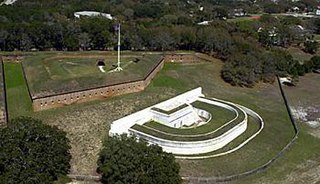
Fort Barrancas (1839) or Fort San Carlos de Barrancas is a United States military fort and National Historic Landmark in the former Warrington area of Pensacola, Florida, located physically within Naval Air Station Pensacola, which was developed later around it.

The Lake McDonald Lodge Historic District is a historic district in Glacier National Park in the U.S. state of Montana. It comprises the Lake McDonald Lodge and surrounding structures on the shores of Lake McDonald. It is centered on the main lodge, which was designated a National Historic Landmark in 1987, as well as surrounding guest cabins, dormitory buildings, employee residences, utility buildings, and retail structures. The district includes several privately owned inholding structures that are contributing structures, as well as a number of non-contributing buildings.

Sperry Chalet is located about seven miles east of Lake McDonald in Glacier National Park in the U.S. state of Montana. The chalet was opened in 1914 by the Great Northern Railway and was a National Historic Landmark contributing property, being one of five structures in the Great Northern Railway Buildings National Historic Landmark. Along with Granite Park Chalet, Sperry Chalet is one of the two remaining backcountry chalets in Glacier National Park, both operated by Belton Chalets, Inc.

National Park Service rustic – sometimes colloquially called Parkitecture – is a style of architecture that developed in the early and middle 20th century in the United States National Park Service (NPS) through its efforts to create buildings that harmonized with the natural environment. Since its founding in 1916, the NPS sought to design and build visitor facilities without visually interrupting the natural or historic surroundings. The early results were characterized by intensive use of hand labor and a rejection of the regularity and symmetry of the industrial world, reflecting connections with the Arts and Crafts movement and American Picturesque architecture.

Fire Station No. 9 was located at 2 South 14th Street in Kansas City, Kansas. Designed by William E. Harris, it was declared a Kansas City, Kansas Historic Landmark on June 16, 1983. The fire station was placed on the Register of Historic Kansas Places on July 3, 1979, and the National Register of Historic Places on September 5, 1985. It has also been known as the Prescott Neighborhood Center. The building is currently owned and occupied by Community Housing of Wyandotte County. The new Fire Station No. 9 is located at 1100 Central Ave. in Kansas City, Kansas.
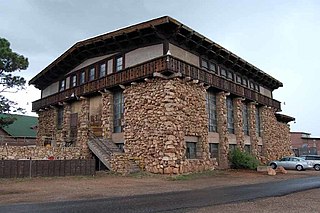
Grand Canyon Power House is a former electric power plant that served National Park Service and concessioner facilities at the South Rim of the Grand Canyon in Grand Canyon National Park. It is significant for its architecture, which masks the building's industrial function behind a veneer of rustic design. It has been designated a National Historic Landmark on the basis of its design quality and the level of preservation of its equipment.

The Great Northern Railway Buildings are a set of five building complexes in or near Glacier National Park in Montana. They were built by the Great Northern Railway during the period of the park's founding to provide a unified tourist experience to visitors to the park, using the Swiss chalet as a building model. The building complexes, each separately listed on the National Register of Historic Places, are:

Oregon Caves Historic District covers 6 acres (24,000 m2) in the main visitor area of Oregon Caves National Monument in southern Oregon. The district includes four primary buildings plus two other structures. Because of the unique rustic architecture of these National Park Service buildings and the surrounding park landscape, the area was listed on the National Register of Historic Places in 1992.

The Fort Peck Theatre was built as a temporary structure in 1934 in Fort Peck, Montana to serve as a movie theatre. It is also known as the Fort Peck Summer Theatre. The theater was designed in a pseudo-Swiss-chalet style as an amenity for the 50,000 U.S. Army Corps of Engineers workers and their families at the Fort Peck Dam project. The interior features open-truss wood construction, with handcrafted light fixtures fabricated in Corps of Engineers workshops. The theater survived to become a permanent facility, and in 2008 was in use as a community theater.

The Tiller Ranger Station is a United States Forest Service compound consisting of twenty-seven buildings in Oregon’s Umpqua National Forest. Over the years, it has been the administrative headquarters for five ranger districts. It is located in the small unincorporated community of Tiller, Oregon, United States. The historic structures were built in the rustic style by the Civilian Conservation Corps between 1935 and 1942. Today, the ranger station is the headquarters for the Tiller Ranger District, and is listed on the National Register of Historic Places.
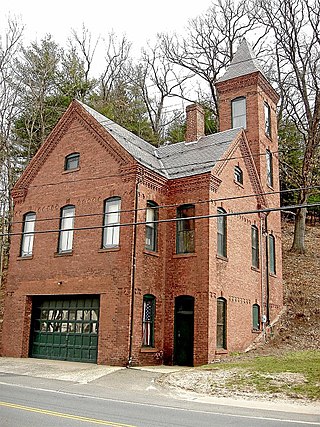
The Tunxis Hose Firehouse is an historic firehouse at Lovely Street and Farmington Avenue in the center of Unionville, Connecticut. BUilt in 1893, it is a well-preserved example of a late 19th-century rural firehouse with Queen Anne Victorian features. The building was listed on the National Register of Historic Places on July 28, 1983. It presently houses a muster vehicle for Tunxis Hose Company No. 1, a local volunteer fire company.

The Stratford Center Historic District is a 220-acre (89 ha) historic district in Stratford, Connecticut. The district was listed on the National Register of Historic Places in 1983. It then included 257 contributing buildings.
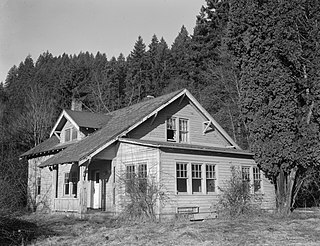
Randle Ranger Station-Work Center in Gifford Pinchot National Forest near Randle, Washington was built during 1935-36 by the Civilian Conservation Corps. It was listed on the National Register of Historic Places in 1986 for its architecture. It was designed by the USDA Forest Svce. Architecture Group in Rustic architecture. The listing included seven contributing buildings including a single dwelling, a secondary structure, a warehouse, and a fire station on a 5-acre (2.0 ha) area.

Portland Fire Station No. 7, located in southeast Portland in the U.S. state of Oregon, is a two-story structure listed on the National Register of Historic Places. Built in 1927, it was added to the register in 1989. It was the last of numerous Portland firehouses to be designed by fire chief and architect Lee Gray Holden, who died of a stroke while visiting the No. 7 firehouse in 1943. The building continued to be used by the city's Fire Department until the 1980s, when it was sold off and used as an automobile garage. It was acquired by a local developer in 2009, and was restored and remodeled for office and retail use.
Johnson, Drake & Piper was a construction contracting firm.
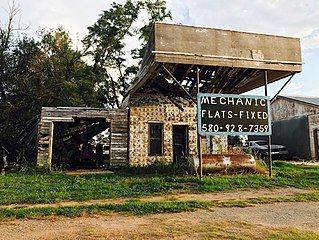
The Magnolia Service Station is a historic service station located on Old U.S. Route 66 in Texola, Oklahoma. The station, an affiliate of the Magnolia Petroleum Company, opened circa 1930. The station was one of the westernmost in Oklahoma and became one of the first stops for eastbound travelers to buy gas and auto services in the state. The main building of the service station is representative of the "house" style of filling station; such stations resembled small houses in order to fit into residential areas.

The Dearborn City Hall Complex is a complex of three government buildings located at 13615 Michigan Avenue in Dearborn, Michigan. The complex includes the 1921 Dearborn City Hall, the 1929 Police and Municipal Courts Building, and an office/auditorium concourse addition constructed in 1981. The complex was listed on the National Register of Historic Places in 2014.

The District 6 School House is a historic school building at 73 Cemetery Circle in Lyndon, Vermont. Built in 1857, it served as a school until 1900, and saw use in the 20th century as a garage, storage facility, and museum. It was listed on the National Register of Historic Places in 2006.






















